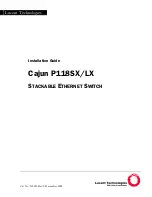
Optimizing Traffic Flow with Port Controls, Port Trunking, and Port-Based Priority
Port Trunking
Table 10-6.
LACP Trunk Types
LACP Port Trunk
Configuration
Operation
Dynamic LACP
This option automatically establishes an
802.3ad-compliant
trunk group, with
LACP
for the port Type
parameter and
DynX
for the port Group name, where
X
is an automatically assigned value from 1 to 6,
depending on how many dynamic and static trunks are currently on the switch. (The switch allows a
maximum of six trunk groups in any combination of static and dynamic trunks.)
Under the following conditions, the switch automatically establishes a dynamic LACP port trunk group
and assigns a port Group name:
• The ports on both ends of a link have compatible mode settings (speed and duplex).
• The port on one end of a link must be configured for LACP Active and the port on the other end of
the same link must be configured for either LACP Passive (the default) or LACP Active. For example:
Switch 1
Port X:
LACP Enable:
Active
Port Y:
LACP Enable:
Active
Switch 2
Port A:
LACP Enable:
Active
Port B:
LACP Enable:
Passive
Active-to-Active
Active-to-Passive
Either of the above link configurations allow a dynamic LACP trunk link.
Standby Links:
A maximum of four operating links are allowed in the trunk, but, with dynamic LACP, you
can configure one or more backup links that the switch automatically activates if a primary link fails.
To configure a link as a standby for an existing four-port dynamic LACP trunk, ensure that the ports in
the standby link are configured the same as either of the above examples.
Displaying Dynamic LACP Trunk Data:
To list the configuration and status for a dynamic LACP trunk,
use the CLI
show lacp
command.
Note:
The dynamic trunk is automatically created by the switch, and is not listed in the static trunk
listings available in the menu interface or in the CLI
show trunk
listing.
Static LACP
The trunk operates if the trunk group on the opposite device is running one of the following trunking
protocols:
• Active LACP
• Passive LACP
• Trunk
• FEC
This option uses
LACP
for the port Type parameter and
Trk
X
for the port Group parameter, where
X
is an automatically assigned value from 1 to 6, depending on how many static trunks are currently
operating on the switch. (The switch allows a maximum of six trunk groups in any combination of static
and dynamic trunks.)
Displaying Static LACP Trunk Data: To list the configuration and status for a static LACP trunk, use the
CLI
show lacp
command. To list a static LACP trunk with its assigned ports, use the CLI
show trunk
command or display the menu interface Port/Trunk Settings screen.
Static LACP does not allow standby ports.
10-26
Содержание ProCurve 6108
Страница 2: ......
Страница 18: ... This page is intentionally blank xvi ...
Страница 50: ...Using the Menu Interface Where To Go From Here This page is intentionally unused 3 16 ...
Страница 110: ...Switch Memory and Configuration Using Primary and Secondary Flash Image Options This page is intentionally unused 6 20 ...
Страница 300: ...Port Based Virtual LANs VLANs and GVRP GVRP This page is intentionally unused 12 48 ...
Страница 432: ...IP Routing Features Configuring DHCP Relay This page is intentionally unused 16 24 ...
Страница 522: ...Troubleshooting Restoring a Flash Image This page is intentionally unused C 44 ...
Страница 528: ...MAC Address Management Determining MAC Addresses This page is intentionally unused D 6 ...
Страница 532: ...Daylight Savings Time on HP ProCurve Switches This page is intentionally unused E 4 ...
Страница 546: ... This page is intentionally unused 14 Index ...
















































